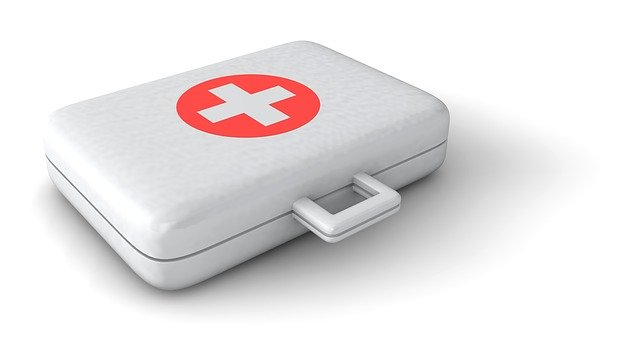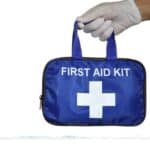
The unforeseen are part of our day to day and our pets are not left out of it, so we consider it important to have a first aid kit prepared in advance for our rabbits. For this reason we have created a list with the basic elements that a first-aid kit should have for our little ears.
Contents of a first aid kit for rabbits
It would be good if you had certain things at home that will come in handy in case you have to treat wounds, to take care of their hygiene or other basic needs that arise.
- Critical Care: porridge for when you don’t want or can’t eat on your own. This mix of Timothy hay, vitamins, supplements, etc. helps normalize digestion in critical cases when animals cannot eat on their own due to disease, surgery or poor nutrition.
- Gauze: to heal wounds.
- Betadine : to heal wounds.
- Chlorhexidine (Crystalline): to heal wounds.
- Physiological serum: It will serve to wash wounds, clean ears / eyes and reduce Betadine or Chlorhexidine.
- 1 milliliter syringes without needle: necessary when it comes to medicating, hydrating or feeding them when it is sick.
- Digital thermometer : You will know if your bunny has a fever or not.
- Vaseline: Useful to spread it on the thermometer when taking the temperature. and thus avoid doing any kind of harm.
- Special scissors: essential when cutting your nails. (Although we recommend that this be done by an expert, since cutting the nails wrong can cause problems in our little one)
- Round tip scissors: in case you have to trim hair.
- Brush: with which you will drag loose hairs.
- Malta: It is necessary to give it often to help digest the hairballs in the stomach of our rabbit.
- Chamomile : Chamomile has anti-inflammatory properties, you can use it if your rabbit has mild eye irritations. Its aroma can also help your rabbit drink.
- Blocks of water to freeze: for cases of hyperventilation or high temperatures.
- Mat or hot water bottle: for cases of hypothermia (low temperature).
- A small towel: so you can keep the rabbit still and calm while you force-feed it.
- Blastoestimulin: to heal wounds and also has antibiotic action. It is not toxic.
- Small flashlight: To examine ears.
How do I know if my rabbit has a fever?
Fever in rabbits works the same as ours and that of many other animals: it is a defense mechanism of the body to fight against pathogens that cause diseases. But too high a fever can be just as dangerous, and body temperature needs to be restored. The best way to detect fever in rabbits is undoubtedly to measure body temperature with a rectal thermometer. Its normal body temperature is between 38.5ºC and 40ºC, so if it exceeds 40ºC it is considered that a rabbit has a fever. That is why it is very important that a thermometer is part of our first aid kit for rabbits.
Although the most effective and objective way to know if a rabbit has a fever is to measure the temperature, there are some changes that also appear. These changes include variations in behavior such as apathy and lack of appetite, and a hot and dry nose can also be found at times.
What to do if my rabbit has a fever?
Now you know how to know if your rabbit has a fever or not, it is better that you take him to the vet so that he can treat him correctly because, as we have mentioned, fever could be a symptom of a serious illness.
If you are unable or unavailable to an exotic veterinarian, make sure your rabbit drinks plenty of water and has access to enough fluids. We can put a bottle of frozen water under a towel and our rabbit on top to try to lower the temperature. Remember that rabbits should not get wet. This should only be carried out in the event that a vet is not accessible.
How to cut my rabbit’s nails?
The nails on the front legs of rabbits grow faster than the back ones, so they will need to be trimmed more often. How often will depend a lot on the speed at which the nails grow, which varies. However, every 4 or 6 weeks it is quite likely that the time has come to cut your nails.
Aspects to consider:
Before cutting your rabbit’s nails, keep in mind:
- You will need the help of one or perhaps two people, because although they are small rabbits can move with great force when they feel threatened.
- You will need a special scissors to cut rabbit nails or, failing that, one for cats.
- They have four nails and a spur (located on the inside) on the front legs, and four nails on the back.
- The nails have an inclined shape, so you must respect this when making the cut.
- Rabbit nails are very delicate and you could hurt them if you cut them incorrectly. Each nail has a white section and inside this you can see a red part, which is called living flesh. Live meat is made up of blood vessels and under no circumstances should it be cut, as it is painful for your rabbit and could bleed out. If your nails are darker, bring a light up to detect the area where the raw flesh is, which will look like a stain. You should always cut away from that section, only at the ends.
- If you cut more than you should, you should immediately apply a blood thinner to stop the bleeding.
- Throughout the process, reassure the rabbit with strokes and sweet words.
- Cut your nails in a bright place, to avoid accidents.
See your vet to have your rabbit’s nails trimmed if you can’t do it yourself. Remember that the most important thing is the health of your pet, so if you do not feel safe and you are afraid, it is best that you leave this job to the professionals.






